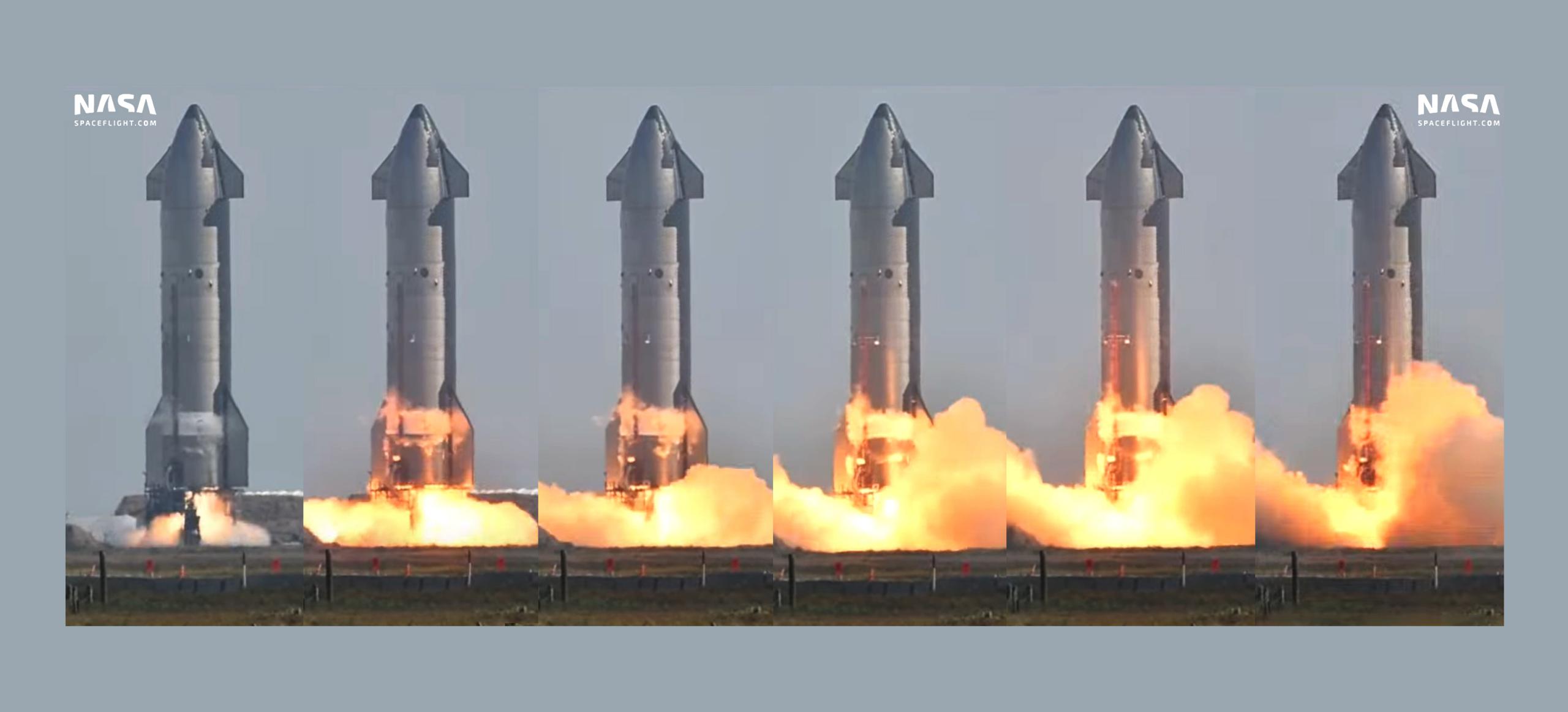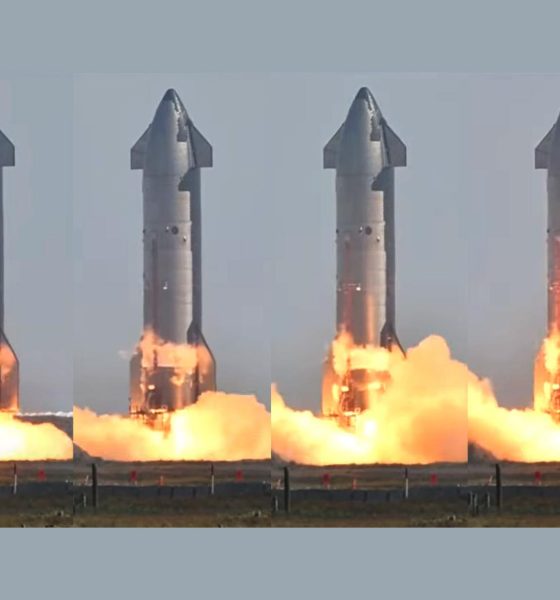In its true last act of the year, SpaceX successfully fired up its first orbital-class Starship for the fourth time in approximately two months, placing the prototype one step closer to flight readiness.
Starship S20 first left its roost in SpaceX’s Starbase factory in early August, briefly performing a fit test atop Super Heavy Booster 4 (B4) – both only partially complete at the time. Both returned to their nests for finishing touches soon after. However, relative to almost all other prototypes SpaceX has built in South Texas in the last two years, Starship S20’s path to flight readiness has been a long and windy one. It took SpaceX a full eight weeks after that first rollout to prepare Ship 20 for – and complete – its first cryogenic proof test, in which the rocket was pressurized and filled with hundreds of tons of liquid nitrogen (LN2).
It took another three weeks after that milestone for SpaceX to then prepare Ship 20 for an even more important test – its first Raptor engine static fire.
The process began on October 19th with Ship 20’s first Raptor preburner test, in which smaller secondary combustion chambers designed to supply the engine’s main combustion chamber with a combustible mixture were briefly ignited on their own. On October 21st, that next milestone finally came, with Starship S20 not only completing the first on-pad static fire of a Raptor Vacuum engine but also performing a second test during the same window, firing up the same RVac and a gimballing Raptor Center (RC) engine less than an hour later. It was an impressive leap in apparent confidence, with Ship 20 jumping from the slowest prototype to reach a testing milestone to the first prototype of any kind to complete back-to-back static fires less than an hour apart.
After another unusually long three weeks of work, some of which was spent installing four more Raptors on Starship S20, the ship completed a second preburner test – the first of any kind to simultaneously feature or involve six Raptor engines. Unlike the first campaign, which had a two-day gap, SpaceX then turned S20 around in the same window and performed the first six-Raptor Starship static fire 50 minutes later – both a success, according to CEO Elon Musk.
Another Ship 20 static fire was subsequently attempted another three or so weeks later, ultimately resulting in an abort on December 1st. Only four weeks later did SpaceX try again, successfully completing what appeared to be Starship S20’s second six-engine static fire without issue on December 29th. The company attempted a second static fire a few hours later but that try was less lucky, culminating in an abort seconds before ignition and wrapping up the day’s testing. That brings us to today, January 2nd, 2022, where SpaceX is once again preparing for more Ship 20 testing with eight-hour windows on January 4th, 5th, and 6th.
The goals of these continued static fire tests are less clear than some past SpaceX testing but Ship 20 – the first orbital-class prototype and first Starship to test more than three Raptors at a time – is a valuable pathfinder. While SpaceX would likely have benefitted even more from them weeks or months, all lessons learned from Ship 20 will help guide retroactive modifications and proactive design changes for upcoming prototypes – the statuses of which are currently in flux.

News
Tesla FSD fleet is nearing 7 billion total miles, including 2.5 billion city miles
As can be seen on Tesla’s official FSD webpage, vehicles equipped with the system have now navigated over 6.99 billion miles.

Tesla’s Full Self-Driving (Supervised) fleet is closing in on almost 7 billion total miles driven, as per data posted by the company on its official FSD webpage.
These figures hint at the massive scale of data fueling Tesla’s rapid FSD improvements, which have been quite notable as of late.
FSD mileage milestones
As can be seen on Tesla’s official FSD webpage, vehicles equipped with the system have now navigated over 6.99 billion miles. Tesla owner and avid FSD tester Whole Mars Catalog also shared a screenshot indicating that from the nearly 7 billion miles traveled by the FSD fleet, more than 2.5 billion miles were driven inside cities.
City miles are particularly valuable for complex urban scenarios like unprotected turns, pedestrian interactions, and traffic lights. This is also the difference-maker for FSD, as only complex solutions, such as Waymo’s self-driving taxis, operate similarly on inner-city streets. And even then, incidents such as the San Francisco blackouts have proven challenging for sensor-rich vehicles like Waymos.
Tesla’s data edge
Tesla has a number of advantages in the autonomous vehicle sector, one of which is the size of its fleet and the number of vehicles training FSD on real-world roads. Tesla’s nearly 7 billion FSD miles then allow the company to roll out updates that make its vehicles behave like they are being driven by experienced drivers, even if they are operating on their own.
So notable are Tesla’s improvements to FSD that NVIDIA Director of Robotics Jim Fan, after experiencing FSD v14, noted that the system is the first AI that passes what he described as a “Physical Turing Test.”
“Despite knowing exactly how robot learning works, I still find it magical watching the steering wheel turn by itself. First it feels surreal, next it becomes routine. Then, like the smartphone, taking it away actively hurts. This is how humanity gets rewired and glued to god-like technologies,” Fan wrote in a post on X.
News
Tesla starts showing how FSD will change lives in Europe
Local officials tested the system on narrow country roads and were impressed by FSD’s smooth, human-like driving, with some calling the service a game-changer for everyday life in areas that are far from urban centers.

Tesla has launched Europe’s first public shuttle service using Full Self-Driving (Supervised) in the rural Eifelkreis Bitburg-Prüm region of Germany, demonstrating how the technology can restore independence and mobility for people who struggle with limited transport options.
Local officials tested the system on narrow country roads and were impressed by FSD’s smooth, human-like driving, with some calling the service a game-changer for everyday life in areas that are far from urban centers.
Officials see real impact on rural residents
Arzfeld Mayor Johannes Kuhl and District Administrator Andreas Kruppert personally tested the Tesla shuttle service. This allowed them to see just how well FSD navigated winding lanes and rural roads confidently. Kruppert said, “Autonomous driving sounds like science fiction to many, but we simply see here that it works totally well in rural regions too.” Kuhl, for his part, also noted that FSD “feels like a very experienced driver.”
The pilot complements the area’s “Citizen Bus” program, which provides on-demand rides for elderly residents who can no longer drive themselves. Tesla Europe shared a video of a demonstration of the service, highlighting how FSD gives people their freedom back, even in places where public transport is not as prevalent.
What the Ministry for Economic Affairs and Transport says
Rhineland-Palatinate’s Minister Daniela Schmitt supported the project, praising the collaboration that made this “first of its kind in Europe” possible. As per the ministry, the rural rollout for the service shows FSD’s potential beyond major cities, and it delivers tangible benefits like grocery runs, doctor visits, and social connections for isolated residents.
“Reliable and flexible mobility is especially vital in rural areas. With the launch of a shuttle service using self-driving vehicles (FSD supervised) by Tesla in the Eifelkreis Bitburg-Prüm, an innovative pilot project is now getting underway that complements local community bus services. It is the first project of its kind in Europe.
“The result is a real gain for rural mobility: greater accessibility, more flexibility and tangible benefits for everyday life. A strong signal for innovation, cooperation and future-oriented mobility beyond urban centers,” the ministry wrote in a LinkedIn post.
News
Tesla China quietly posts Robotaxi-related job listing
Tesla China is currently seeking a Low Voltage Electrical Engineer to work on circuit board design for the company’s autonomous vehicles.

Tesla has posted a new job listing in Shanghai explicitly tied to its Robotaxi program, fueling speculation that the company is preparing to launch its dedicated autonomous ride-hailing service in China.
As noted in the listing, Tesla China is currently seeking a Low Voltage Electrical Engineer to work on circuit board design for the company’s autonomous vehicles.
Robotaxi-specific role
The listing, which was shared on social media platform X by industry watcher @tslaming, suggested that Tesla China is looking to fill the role urgently. The job listing itself specifically mentions that the person hired for the role will be working on the Low Voltage Hardware team, which would design the circuit boards that would serve as the nervous system of the Robotaxi.
Key tasks for the role, as indicated in the job listing, include collaboration with PCB layout, firmware, mechanical, program management, and validation teams, among other responsibilities. The role is based in Shanghai.
China Robotaxi launch
China represents a massive potential market for robotaxis, with its dense urban centers and supportive policies in select cities. Tesla has limited permission to roll out FSD in the country, though despite this, its vehicles have been hailed as among the best in the market when it comes to autonomous features. So far, at least, it appears that China supports Tesla’s FSD and Robotaxi rollout.
This was hinted at in November, when Tesla brought the Cybercab to the 8th China International Import Expo (CIIE) in Shanghai, marking the first time that the autonomous two-seater was brought to the Asia-Pacific region. The vehicle, despite not having a release date in China, received a significant amount of interest among the event’s attendees.










